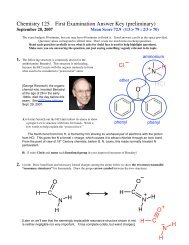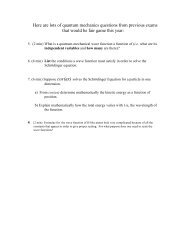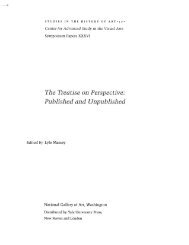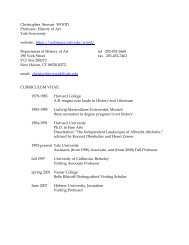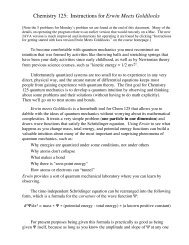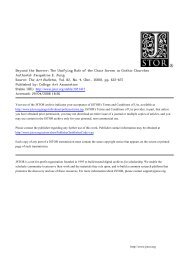ERRATA IN DO CARMO, DIFFERENTIAL GEOMETRY OF CURVES ...
ERRATA IN DO CARMO, DIFFERENTIAL GEOMETRY OF CURVES ...
ERRATA IN DO CARMO, DIFFERENTIAL GEOMETRY OF CURVES ...
Create successful ePaper yourself
Turn your PDF publications into a flip-book with our unique Google optimized e-Paper software.
<strong>ERRATA</strong> <strong>IN</strong> <strong>DO</strong> <strong>CARMO</strong>,<strong>DIFFERENTIAL</strong> <strong>GEOMETRY</strong> <strong>OF</strong> <strong>CURVES</strong> AND SURFACESBJORN POONENThis is a list of errata in do Carmo, Differential Geometry of Curves and Surfaces, Prentice-Hall, 1976 (25th printing). The errata were discovered by Bjorn Poonen and some students inhis Math 140 class, Spring 2004: Dmitriy Ivanov, Michael Manapat, Gabriel Pretel, LaurenTompkins, and Po Yee Wong. Some errata were discovered later by Brent Doyle.• p. 5, line 9, “using properties 3 and 4”: Actually, property 2 also is being used, sinceproperty 4 gives linearity in the second variable only.• p. 5, bottom: The definition of the tangent line is confusing. It is not the line passingthrough the points α(t) and α ′ (t) but rather the line through α(t) in the direction ofα ′ (t), namely { α(t) + λα ′ (t) : λ ∈ R }.• p. 7, Exercise 3, “On 0B mark off the segment 0p = CB.” It would be better to say“On 0B mark a point p such that 0p = CB.”• p. 8, Figure 1-8: The labelling is wrong: the points p and C should lie on the samehalf-line r through 0 as B.• p. 8, Figure 1-8: It might be good to add a point labelled Y on the y-axis.• p. 8, Figure 1-9: The angle labelled t is in the wrong place. (See problem 4 on p. 7.)• p. 13, line 4: Change “It follows from property 4 that the vector product u ∧ v ≠ 0is normal to a plane generated by u and v.” to “It follows from property 4 that ifu and v are linearly independent, then u ∧ v is normal to the plane spanned by uand v.” or better yet, “It follows from properties 3 and 4 that if u and v are linearlyindependent, then u ∧ v is a nonzero vector normal to the plane spanned by u andv.”• p. 13, bottom: Again change “a plane generated by” to “the plane spanned by”• p. 13, bottom: Change “a parallelogram” to “the parallelogram” (twice). Also itwould be better to speak of “the parallelogram formed by u and v” instead of “theparallelogram generated by u and v”.• p. 14, Exercise 5: change “the equation” to “an equation”.• p. 17, line 1, “Therefore, α ′′ (s) and the curvature remain invariant under a change oforientation.”: This is not a direct consequence of the previous statement, so replace“Therefore” by “Similarly”.• p. 18, last sentence: It would be better to change “It follows that” to “Similarly,”• p. 18, last sentence: change “remains” to “remain”.• p. 21: In the right part of Figure 1-16, the labels e 1 and e 2 should be reversed.• pp. 47–48: Exercise 6 is about a convex curve, but the curve in Figure 1-37 is notconvex.• p. 49, Exercise 12: The ratio M 1 /M 2 actually equals 1/2. In the solution on p. 480,the inner integral in the definition of M 1 should go from 0 to 1/2, so M 1 = π.Date: June 9, 2004.1
• p. 57, Figure 2-5: The angle φ should be ϕ to be consistent with the text.• p. 59, proof of Proposition 2: change “axis” to “axes”.• p. 59, proof of Proposition 2: change “in R 3 where F takes its values” to “in theimage of F ”.• p. 61, before Example 3: The notion of “connected” given here is usually called “pathconnected”. (But the definitions are equivalent in the case of regular surfaces, so noharm is done.)• p. 61, 8th line from bottom: change “by contradiction” to “for sake of obtaining acontradiction”.• p. 70, Proposition 1: There’s no need to mention p.• p. 71, middle, before third display: change “axis” to “axes”.• p. 72, Definition 1: This requires the notion “V is open in S”, which is not defineduntil the appendix to Chapter 5. The definition of that notion should appear earlierin the book.• p. 72, third line after Definition 1: p ∈ x(V ) should be p ∈ y(V ).• p. 76, Example 4: The definition of regular curve does not force C to be connected,so the assumption that C does not meet the z-axis needs to be replaced by theassumption that C is contained in the open right half of the xz-plane.• p. 76, Example 4, first display: It is confusing to include the last inequality f(v) > 0here, since it is not part of the parametrization, but rather a hypothesis on f.• p. 81: Exercise 10 is poorly stated. It is not clear whether p and q are in C. Asdefined, regular curves are not supposed to have “endpoints”. But if p and q are notpart of C, and C is contained in the open right half-plane, then we get a regularsurface of revolution automatically.• p. 82: Exercise 15b is wrong as stated, even if one assumes t 0 = h(τ 0 ). For instance,if C is a circle, then the left and right hand sides could be the lengths of the majorand minor arcs connecting two points, respectively. In other words, h might not bedefined on the whole interval [τ 0 , τ], in which case one cannot perform the substitutionto transform one integral into the other.• p. 85, Figure 2-24: change φ to ϕ (twice).• p. 88, Exercise 3: “Tangent plane” means two different things in the two parts of thisproblem. In the first part, it is a plane passing through p 0 . In the second part, it isa subspace of R 3 , that is, a plane passing through the origin.• p. 94, Example 3: In the parametrization, there is no need to restrict u to the interval(0, 2π).• p. 97, definition of domain: It is not clear whether the boundary is the boundary asa subset of R 3 or the boundary as a subset of S. Either way, we run into trouble.If it is the boundary in R 3 , then a region in S need not be contained in S! Forinstance, if we slice an infinite cylinder in two (with a circular cross section), S couldbe one of the open halves, so its boundary is the circle, and its closure is a region inS!If it is the boundary in S, then just below Figure 2-28 the assumption that R isbounded does not imply that Q = x −1 (R) is bounded, and the integral defining thearea could diverge.2
Perhaps one should require in the definition of domain that its closure in S becompact?• p. 99, Exercise 2: Add a comma between ϕ and θ.• p. 100, Exercise 8: change “quadratic” to “fundamental”.• p. 109, Exercise 1: One must assume that V 1 and V 2 are connected.• p. 118, definition of “neighborhood”: It is more common to define a neighborhood ofp to be any set (open or not) that contains an open set containing p.• p. 120, sentence after the second display beginning “In other words,”: This sentenceis incorrect and should be deleted.• pp. 121–122, proof of Proposition 1: The notation S δ (p) should be replaced by B δ (p),which was used earlier to denote balls. (This appears in three places.)• p. 122, end of Example 4: R n should be R m .• p. 123, definition of “continuous in A”: It is more common to define this to meanthat for all a ∈ A and all ɛ > 0, there exists δ > 0 such that the conditions x ∈ Aand |x − a| < δ imply |F (x) − F (a) < ɛ. This definition agrees with continuity withrespect to the subspace topology on A, whereas do Carmo’s definition does not. (Tosee that the definitions do not agree, consider A = R − {1/n : n ≥ 1}, and defineF : A → R so that F (x) = 1/n if x ∈ (1/(n + 1), 1/n) for some integer n ≥ 1, andF (x) = 0 otherwise. This should be continuous on A, but is not by do Carmo’sdefinition.)• p. 124, Proposition 5: The statement should begin “Let f : [a, b] → R”.• p. 124, Proposition 6 (Heine-Borel): The set I has not been defined. Also, the I αneed to be open as subsets in [a, b], not open intervals in R that are contained in [a, b].Since this appendix has not defined the notion of one set being open in another, itwould be best to restate the result as follows:Let [a, b] be a closed interval, and let I α , α ∈ A, be a collection of openintervals such that [a, b] ⊆ ⋃ α I α. Then it is possible to choose a finitenumber I k1 , . . . , I kn of I α such that [a, b] ⊆ ⋃ ni=1 I k i.• p. 125, line -2: the word “performed” should perhaps be changed to “taken”.• p. 127, Definition 1, “we associate a linear map”: It is not proved to be linear untilthe next Proposition 7. So perhaps it is better to call it just a “map” at this point.• p. 132, line -3: The second left hand side should have (0, 1) instead of (1, 0).• p. 136, Definition 1: Delete the | after the semicolon in the display.• p. 146, 4 lines from the bottom, “any of the sides of the tangent plane”: it wouldbetter to replace “any” with “either”.• p. 147, just after Definition 8: It would make more sense to refer to Example 5 insteadof “the method of Example 6”.• p. 153, second line from the bottom: “parametrization” should be “parametrizations”.• p. 154, line 4, “all functions to appear below denote their values at the point p”:Strictly speaking, some of the functions are functions of t and should be evaluatedat t = 0.• p. 154, near the bottom: “coefficientes” should be “coefficients”.3
• p. 155: It may be preferable to write equation (3) in the form( ) ( ) ( )e f E F a11 a− =12,f g F G a 21 a 22(the transpose of the current version of the equation), so that the matrix (a ij ) thatappears in it is exactly the matrix of dN p , instead of its transpose.• p. 155, middle, just before the formula for a 11 : Each x in {x u , x v } should be bold.• p. 161, line 2 of Example 4: change “changed” to “replaced”.• p. 162, middle, “If a parametrization of a regular surface is such that F = f = 0, thenthe principal curvatures are given by e/E and g/G.” A more enlightening explanationof this is given by the equation following equation (3) on page 155.• p. 214, first display: Some indices are backwards (the ij-th entry of a matrix istraditionally the entry in the i-th row and j-th column, and in fact this conventionis followed on page 154). Change this line to the following:α ij = 〈Ae j , e i 〉 = 〈e j , Ae i 〉 = 〈Ae i , e j 〉 = α ji ;• p. 215, Lemma: The letter “a” of the word “at” should be italicized.• p. 221, top right of Figure 4-2: dφ p (W ) should be dφ p (w).• pp. 224–225: The function F is being confused with F ◦ x (which appears on page225). For F to be a function from U to R 3 , it should be defined as a function of xand y. For F ◦ x to make sense, F should be a function of x, y, z. But F was definedas a function of ρ and θ!• p. 226, display in Definition 3: Since the subscript p is used on the inner product onthe right, it would make sense to use the subscript ϕ(p) on the left.• p. 226, second to last display: The range for θ should be 0 ≤ θ ≤ π.• p. 227, sentence after Proposition 2: With the given definition of local conformality,it seems to be very difficult to prove that it is a symmetric relation, unless oneaccepts the unproven theorem on page 227. Also, the sentence as written misleadinglysuggests that transitivity is the only property required for an equivalence relation.• p. 232, end first paragraph: Italicize the first appearance of “Christoffel symbols”instead of the second.• p. 234, sentence after Theorema Egregium: Presumably the codomain of ϕ was supposedto be a possibly different surface ¯S. In this case, the S near the end of thissentence also should be ¯S.• p. 238, sentence before Definition 1: Start this sentence with “The vector field” (toavoid starting it with the mathematical symbol w), and change “for every p ∈ U” to“at every p ∈ U”.• p. 239, middle: “Sec. 4-1” should be “Sec. 4-3”.• p. 239: In (1), the functions a and b depend on the curve α, so it should be explainedthat the values of a ′ and b ′ depend on α only through its tangent vector.• p. 243, Figure 4-12: φ should be ϕ.• p. 245, Figure 4-14: φ should be ϕ (4 times).• p. 245, last line of Definition 8: “for all t ∈ I” should be “at all t ∈ I” (to match theprevious part of Definition 8).• p. 246, Example 3: “there exists exactly one geodesic C ⊂ S passing through p andtangent to this direction”. Strictly speaking, any connected open neighborhood of4
p in C will be another geodesic, so strictly speaking it is not quite unique. Thissloppiness persists throughout the section. For instance:– p. 246, end of Example 3: Great circles are not the only geodesics on the sphere:arcs of great circles (including the empty arc!) are also geodesics.– p. 247, last paragraph, first sentence: lines are not the only geodesics of theplane (open intervals in lines are also geodesics)– p. 260, Exercise 3: Same comment.• p. 248, Definition 10: change “contained on” to “contained in”.• p. 248, last sentence of Definition 10: “[Dα ′ (s)/ds] = k g ” should follow “algebraicvalue”, not “covariant derivative”.• p. 249, Figure 4-18: change φ to ϕ in two places.• p. 249, Figure 4-18: The formula for |k g | can be simplified to |k g | = | cotan ϕ|. (Noneed for the 1!)• p. 249, middle: There is no need to mention k n ; Figure 4-18 shows directly that∣ |k g | = |k cos ϕ| =1∣∣∣∣sin ϕ sin(π/2 − ϕ) = | cotan ϕ|.• p. 249, last line: change “relatively to any” to “relative to either”.• p. 251, middle, “and observing that 〈v, ¯v〉 = 0, 〈v, v ′ 〉 = 0”: After these two equations,“〈¯v, ¯v ′ 〉 = 0” should be inserted, since it also is being used.• p. 253, Proposition 4: change “the angle that x u makes with α ′ (s)” to “the anglefrom x u to α ′ (s)”.• p. 255, Proposition 5: The uniqueness statement should be as follows: For each ɛ > 0for which there exists a parametrized geodesic γ : (−ɛ, ɛ) → S with γ(0) = p andγ ′ (0) = w, such a parametrized geodesic is unique. Maybe it would be better to statea result for an arbitrary interval (a, b) with a < 0 < b. The parametrized geodesicwith minimal a and maximal b (and γ(0) = p and γ ′ (0) = w) is truly unique, and allothers (with γ(0) = p and γ ′ (0) = w) are restrictions of this one to subintervals of(a, b) containing 0.• p. 260, Exercise 1b: “nonrectilinear” is not defined. For this exercise (and for theapplication of this exercise to Exercise 8), I suggest changing this hypothesis to “Cdoes not contain an open segment of a straight line”.• p. 261, Exercise 7(a): The conclusion is false if θ = π/2.• p. 261, Exercise 7(b): It’s not clear what “at the points where C meets their axes” isreferring to. I suggest changing it to “at the endpoints of the major and minor axesof the ellipse” (and adding the assumption 0 < θ < π/2 so that this makes sense).• p. 261, Exercise 10: Since the geodesic curvature could have a sign, it should be madeclear that “the curvature of the plane curve” refers to the signed curvature definedon page 21, using the orientation of T p (S) coming from the orientation of S that isimplicitly used in defining the geodesic curvature. Or else the problem should discussonly the absolute value of the geodesic curvature.• p. 262, Exercise 17: The first conclusion is false: It can happen that for all ɛ > 0, theset x(I × (−ɛ, ɛ)) fails to be a regular surface. (Consider a curve α: (0, 1) → R 3 suchthat α(s) approaches (0, 0, 0) from the same direction as s → 0 + or s → 1 − , and suchthat the part of α near s = 0 is contained in a plane, and the part of α near s = 1 iscontained in a different plane.)5
• p. 282, Exercise 1: One must assume in addition that S is connected. (Otherwise adisjoint union of two spheres is a counterexample.)• p. 282, Exercise 3: One must assume that S has K > 0 everywhere and that N isinjective, so that the area of N(A) can be computed without worrying about sign ormultiplicities.• p. 282, last line (line 2 of Exercise 5): “p /∈ C” should be “p ∈ C”.• p. 282, Exercise 5: ϕ is being used to denote two different things in this problem (thecolatitude, and the angle between two vector fields along C).• p. 425, Definition 1, part 2: There is no need to exclude the case W = ∅; such anexclusion only clutters the definition. I suggest replacing“For each pair α, β with x α (U α ) ∩ x β (U β ) = W ≠ φ, we have that”with“For each pair α, β, if we set W = x α (U α ) ∩ x β (U β ), then”.Exactly the same comment applies to Definition 1a on p. 438.• p. 426, top of Figure 5-46: The subscript on the second U should be β, not p.• p. 426, Remark 1: The statement“This means that any other family satisfying conditions 1 and 2 is alreadycontained in the family {U α , x α }.”neglects the possibility of distinct differentiable structures on the same set. It shouldbe replaced by“This means that the family {U α , x α } is not properly contained in any otherfamily of coordinate charts satisfying conditions 1 and 2 of Definition 1.”• p. 426, Definition 2: This definition is faulty unless one makes the maximality assumptionof Remark 1 on this page. (Without this assumption, it might be impossibleto find x satisfying x(U) ⊂ y(V ).)• p. 427, examples 1 and 2: Change φ to ∅ (once in each example). Also, it would beeasier to read if A ◦ x α (U α ) were replaced by A(x α (U α )) (once in each example).• p. 428, middle of first paragraph: Change“Thus, we must define what is the tangent vector of a curve on an abstractsurface.”to“Thus, we must define what the tangent vector of a curve on an abstractsurface is.”• p. 443, Exercise 3: To make sense of the notion of neighborhood of a point in anabstract surface, one needs a notion of open set. I suggest adding the followingdefinition to the text, perhaps after Remark 1 on p. 426: A subset V of an abstractsurface S is open if and only if x −1α (V ) is open in U α (or equivalently, in R 2 ) for allα.• p. 444, Exercise 5b: “dϕ p = 0” should be “dϕ p is not an isomorphism”.Department of Mathematics, University of California, Berkeley, CA 94720-3840, USAURL: http://math.berkeley.edu/~poonen7


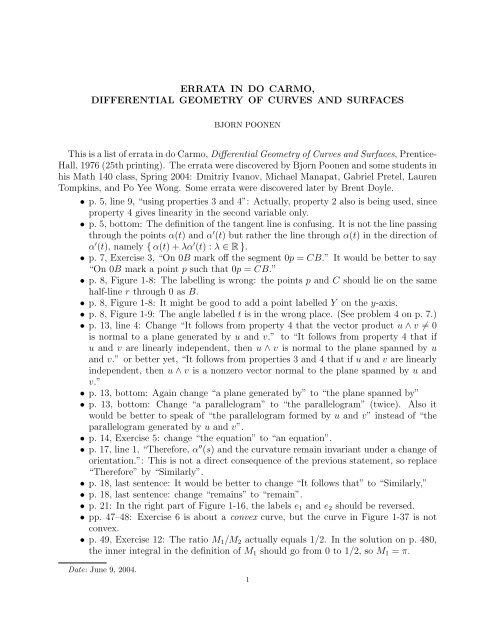
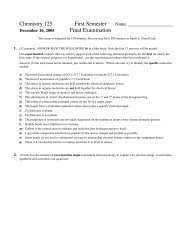
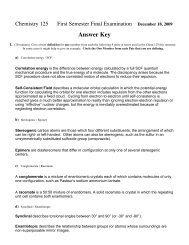
![Review: [untitled] Author(s): Christopher S. Wood ... - Yale University](https://img.yumpu.com/47633680/1/184x260/review-untitled-authors-christopher-s-wood-yale-university.jpg?quality=85)
